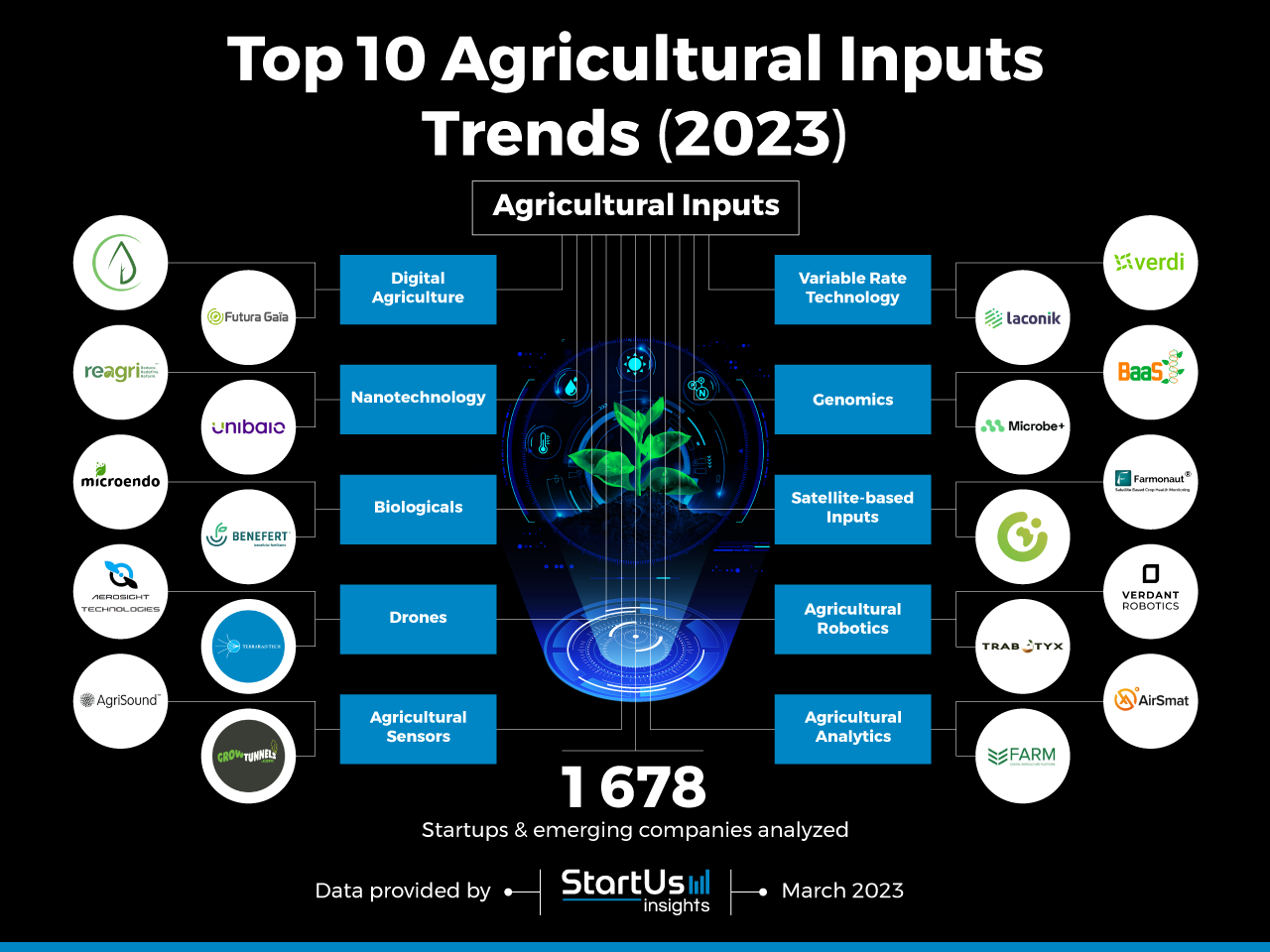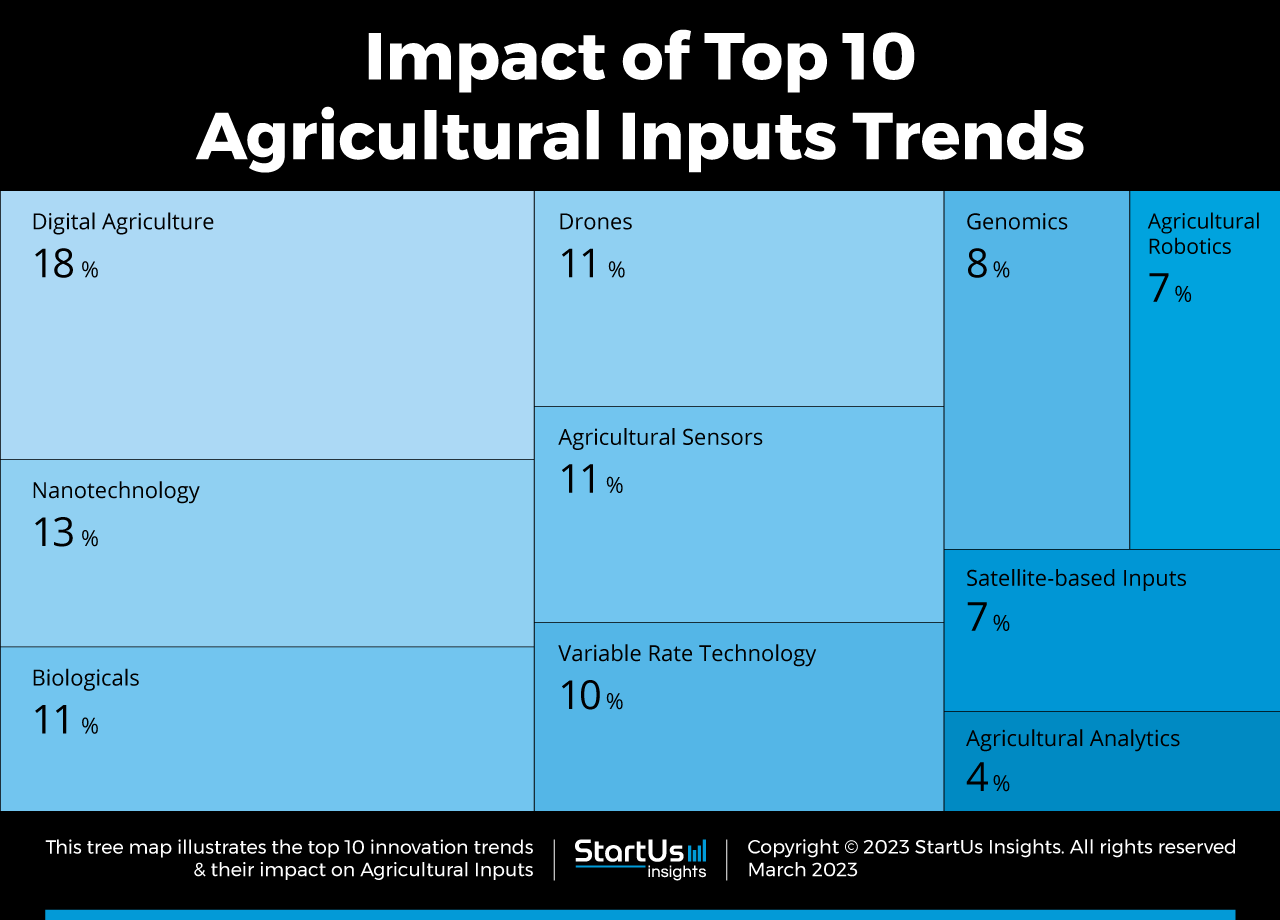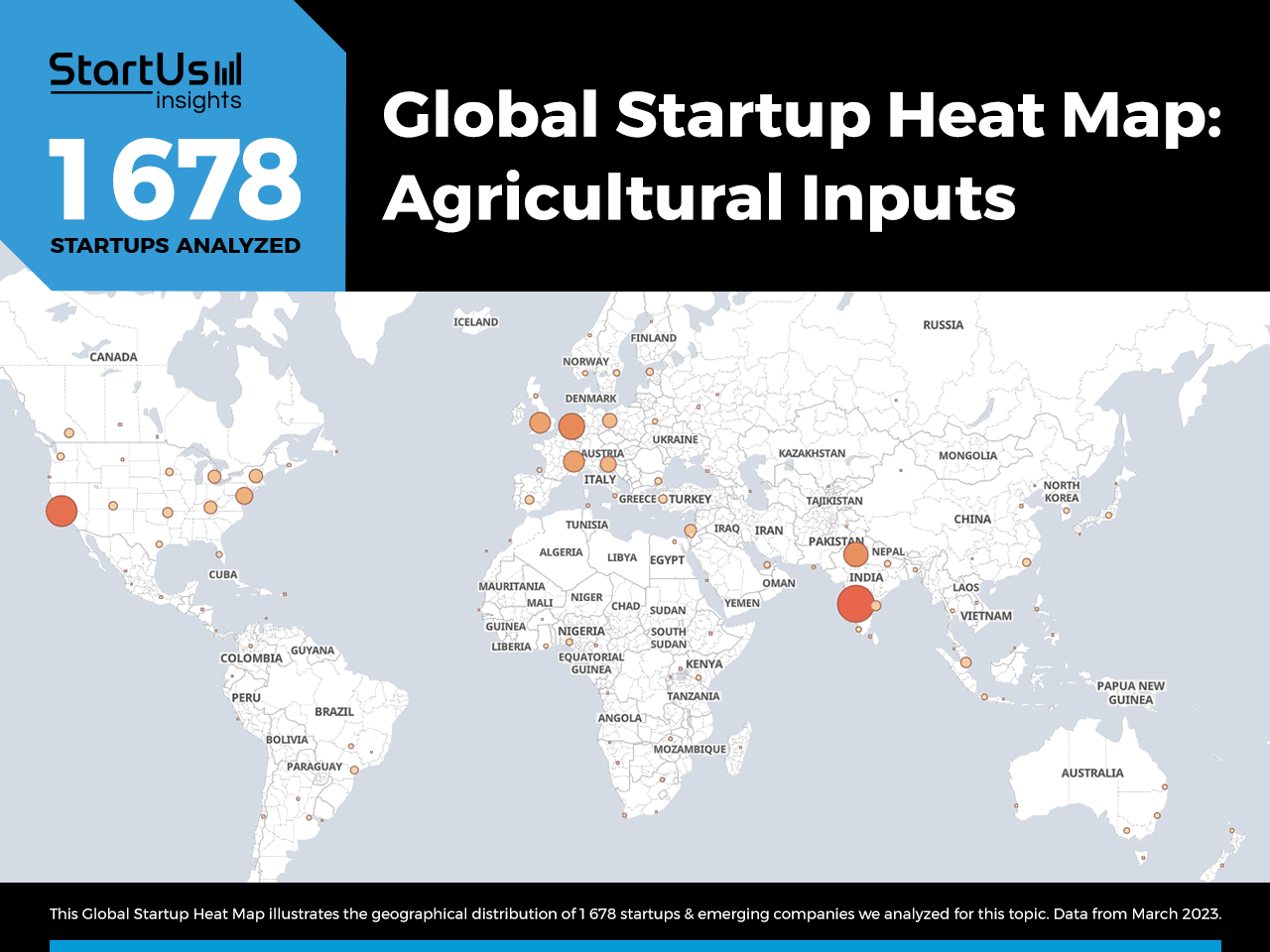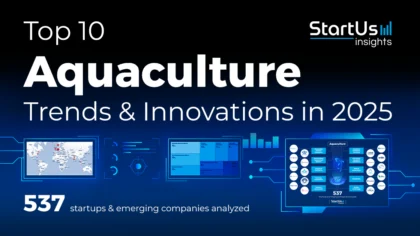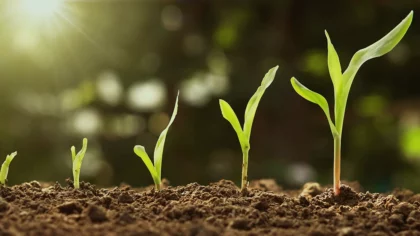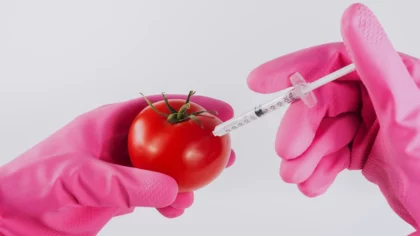Accelerate Productivity in 2025
Reignite Growth Despite the Global Slowdown
Technological advancements in agricultural inputs management improve global food security and sustainability while enhancing the productivity of crop yields. For instance, digital agriculture is transforming the way farmers manage their crops by providing real-time data and insights that optimize crop yields and reduce costs. Nanotechnology solutions enable the development of innovative agricultural products to enhance plant health and nutrition, while biologicals promote sustainable agricultural practices by reducing the use of harmful chemicals. Similarly, AgriTech startups leverage drones, agricultural sensors, and satellite-based inputs to help farmers gather accurate and timely data on crop growth and health. This research provides an overview of the top 10 trends in the development and application of agricultural inputs like fertilizers, pesticides, and more. They enable efficient crop monitoring, irrigation management, and pest control.
Innovation Map outlines the Top 10 Agricultural Inputs Trends & 20 Promising Startups
For this in-depth research on the Top Agricultural Inputs Trends & Startups, we analyzed a sample of 1 678 global AgriTech startups & scaleups. The result of this research is data-driven innovation intelligence that improves strategic decision-making by giving you an overview of emerging technologies & startups in the agriculture industry. These insights are derived by working with our Big Data & Artificial Intelligence-powered StartUs Insights Discovery Platform, covering 3 790 000+ startups & scaleups globally. As the world’s largest resource for data on emerging companies, the SaaS platform enables you to identify relevant startups, emerging technologies & future industry trends quickly & exhaustively.
In the Innovation Map below, you get an overview of the Top 10 Agricultural Inputs Trends & Innovations that impact 1 678 companies worldwide. Moreover, the Agricultural Inputs Innovation Map reveals 20 hand-picked AgriTech startups, all working on emerging technologies that advance their field.
Top 10 Agricultural Inputs Trends in 2023
- Digital Agriculture
- Nanotechnology
- Biologicals
- Drones
- Agricultural Sensors
- Variable Rate Technology
- Genomics
- Satellite-based Inputs
- Agricultural Robotics
- Agricultural Analytics
Tree Map reveals the Impact of the Top 10 Agricultural Inputs Trends
Based on the Agricultural Inputs Innovation Map, the Tree Map below illustrates the impact of the Top 10 Agricultural Inputs Trends in 2023. AgriTech startups and scaleups develop solutions for enhancing the productivity and sustainability of crops. Digital agriculture, the most prevalent trend, allows farmers to optimize agricultural inputs and streamline their operations, while agricultural sensors and satellite-based inputs provide real-time data on crop health and soil moisture. Variable rate technology (VRT) and nanotechnology-based products enable the efficient use of resources and reduce waste. Biologicals and genomics-based solutions enhance crop yields and protect them against diseases and pests. Further, agricultural analytics provide insights into the performance of crops and help farmers make informed decisions on the application of agricultural inputs.
Global Startup Heat Map covers 1 678 Agricultural Inputs Startups & Scaleups
The Global Startup Heat Map below highlights the global distribution of the 1 678 exemplary startups & scaleups that we analyzed for this research. Created through the StartUs Insights Discovery Platform, the Heat Map reveals that India and the US see the most startup activity.
Below, you get to meet 20 out of these 1 678 promising startups & scaleups as well as the solutions they develop. These agricultural inputs startups are hand-picked based on criteria such as founding year, location, funding raised, & more. Depending on your specific needs, your top picks might look entirely different.
Top 10 Agricultural Inputs Trends in 2023
1. Digital Agriculture
The agriculture industry is leveraging technology to support farmers in optimizing their crop input utilization. Startups are developing software solutions for improving crop management practices. These solutions adopt technologies, such as artificial intelligence (AI) and remote sensing, to monitor and protect crops. For example, crop diagnostics software utilizes images captured from the field to diagnose various issues impacting crop health. This includes disease outbreaks, pest infestations, and nutrient deficiencies. Such solutions also enable data-driven decision-making for the application of fertilizers, pesticides, and other inputs. Additionally, farm management software functions as a centralized platform to manage land, crops, and financial records. This allows farmers to increase crop yields in a cost-effective manner.
Circulus Agtech aids Agricultural Waste Management
Canadian startup Circulus Agtech develops organic waste management solutions. The startup leverages ion activity monitoring to precisely assess target key nutrients and upcycles manure and compost to replace synthetic fertilizers. Further, its software uses data analytics to assist farmers in effectively managing the residual organic matter. Additionally, the startup uses AI for achieving an accurate formulation for its organic fertilizers. This enables farmers to digitally manage their crop nutrient cycle and ensure optimal yields.
Futura Gaia simplifies Crop Input Management
French startup Futura Gaia offers an agricultural solution that aids input management. It allows the management of interconnected subsystems such as nutrient supply and water processing. This enables the farmers to remotely control crop inputs. The software also provides real-time data on crop growth for supervision and continuous improvement. As a result, the startup enables them to produce crops with high nutritional value while eliminating the use of heavy pesticides and food wastage.
2. Nanotechnology
The limited availability of natural resources, such as fertile land and quality seeds, is threatening global food security. That is why farmers are leveraging novel agricultural inputs, like nano fertilizers and nano pesticides, along with nano biosensors. Nanoscale fertilizers and pesticides reduce the environmental impact of conventional agriculture practices and enable targeted pest control. Such nanotech-powered agricultural inputs improve the sustainability and productivity of food production systems. On the other hand, nano biosensors detect specific biological compounds in the soil, water, and crops to provide valuable information to improve crop management.
NanoBee offers Nanotech-based Agricultural Inputs
Indian startup NanoBee provides nanotechnology-based agricultural inputs. The startup’s offerings include a crop nutrition solution, BEE-MICRO, and a crop disinfectant, BEE-SICO. For this, NanoBee utilizes eco-friendly and green methods. Its inputs are mixed with water in appropriate amounts and sprayed on the crops. This protects crops from pests, as well as bacterial and fungal infections. Further, they improve the crop’s immune system against pests and increase fertility.
Unibaio develops Biopolymeric Nanocarriers
Argentine startup Unibaio makes biopolymeric nanocarriers for optimizing agrochemicals delivery. The startup’s circular model uses natural compounds like shrimp waste and clay to make the nanocarriers. They encapsulate active ingredients of the pesticides to release slowly over time. Additionally, the particles are used in different types of fertilizers and pesticides, including chemical and organic ones. With the startup’s technology, farmers reduce the required application doses while enhancing the efficacy of agricultural inputs.
3. Biologicals
Naturally occurring microorganisms, such as bacteria, fungi, and viruses, are used to improve crop growth and health. Biofertilizer is one such biological solution that fixes nitrogen from the air into the soil, therefore providing crops with an important nutrient. Further, startups are developing biopesticides to manage pests while reducing the need for chemical pesticides. Startups derive biostimulants from plants, bacteria, and seaweed to grow crops more efficiently, improving their health and yields. The use of biologicals reduces farmers’ dependence on synthetic fertilizers and pesticides, promoting environmental sustainability.
MICROENDO creates Personalized Biofertilizers
Mexican startup MICROENDO creates personalized biofertilizers using the key microorganisms from the plant. The startup identifies the need of the plant microorganism and tailors the biofertilizer to each crop, helping improve the crops’ immune system. For example, its Agave fertilizer, AGAVEPROTECT, strengthens the plant immune system and reduces plant stress. MICROENDO’s personalized biofertilizers thus enable farmers to treat diseases better and restore crop health.
Benefert develops Biostimulants
Benefert is a Dutch startup that offers BeneSTIM, a biostimulant product line. It comprises various biostimulants such as BeneSTIM RECOVERY, BeneSTIM MAXVITAL, and BeneSTIM ROOTS. Each biostimulant affects plant development in a specific manner. These biostimulants include amino acids, plant extracts, fulvic acids, and micronutrients to promote plant metabolic pathways and increase photosynthesis activity. Further, the startup’s biostimulants are combined with fertilizer and crop protection products to improve their efficiency and increase nutrient uptake. Farmers use the startup’s biostimulants for the recovery of crops from abiotic stress and to prevent crop failure.
4. Drones
Unmanned aerial vehicles (UAVs) or drones perform various tasks including diagnosing nutrient deficiencies and pest infestations, mapping fields, and delivering fertilizers. Drones also gather data on soil moisture levels, nutrient levels, and other factors that impact crop growth. Further, fertilizer-spraying drones precisely target specific areas and at the same time cover large areas of land in a short span. Further, startups equip drones with thermal imaging technology to detect crop issues and improve yields for farmers. This allows farmers to improve soil health monitoring and leverage precision agriculture.
TerraRad Tech facilitates Soil Moisture Measurement
Swiss startup TerraRad Tech develops drone-mounted portable L-band radiometers (PoLRas) for measuring soil moisture. This system generates maps of subsurface soil and crop moisture. The maps provide farmers with targeted irrigation prescriptions. Further, they enable optimal watering to reduce the risk of yields being impacted by fungus and mold. Additionally, this minimizes the costly input and fertilizer leaching into the soil. The startup’s technology, in turn, allows farmers to maximize harvests with optimal conditions.
AeroSight Technologies develops Pesticide Spraying Drones
Indian startup AeroSight Technologies manufactures agricultural drones for pesticide spraying, fertilizer application, aerial seeding, and seed dropping. The startup’s product, BLUE JAY, is a multipurpose drone equipped with a 10-liter tank capacity and four nozzles. It efficiently sprays pesticides and simplifies the task of crop management. Alongside this, farmers get a seed-dropping fixture that drops seeds from a certain height with precision and uniformity. This enables faster and easier afforestation and reforestation. AeroSight Technologies also allows farmers to plant seeds in hilly regions and inaccessible places, where human intervention is difficult.
5. Agricultural Sensors
Agricultural sensors monitor crops at multiple stages, from nursery and growth to their harvest. One type of sensor is the low-power image sensor that is placed in the trap. It then sends images of its contents, helping farmers enhance pest analysis. Further, acoustic sensors monitor the noise level of the insects to accurately indicate infestation areas. Farmers also use optical sensors to better understand the fertilizer needs of the plants based on the light reflected back to the sensors. Startups are developing agricultural sensors tailored to enable the real-time application of fertilizers and pesticides, improving crop protection.
AgriSound provides a Pollination In-field Sensor
UK-based startup AgriSound makes an in-field sensor device for monitoring pollination. It combines acoustic and environmental sensing to collect pollination data and transmit them to a data storage platform. It then displays the pollination activity to the farmers through its user interface. This data assists them in identifying the areas of low pollinator activity and intervening to increase the numbers. The startup’s sensors and platforms detect insects and thus improve crop yield and fruit quality.
GROW TWC builds Crop Input Management Sensors
Australian startup GROW TWC builds smart farm sensors for managing agricultural inputs. The startup’s sensors transmit data on air humidity, temperature, and soil moisture to its internet of things (IoT) cloud platform. Further, this helps farmers to access precise agricultural information to minimize the inputs such as water and additional soil fertilization. The startup’s dashboard facilitates real-time monitoring, enabling farmers to maximize their yields and improve crop protection.

6. Variable Rate Technology
Variable rate technology optimizes agricultural input application and reduces labor costs. It utilizes data-driven workflows and automation to adjust the utilization of fertilizers, seeds, crop protection products, and irrigation. This enables farmers to reduce the risk of over-application and combat issues such as uneven crop growth and lower yields. Startups are thus developing VRT systems that assist farmers in applying crop nutrients, seeding, and detecting weeds and diseased crops.
Verdi enables Variable Rate Irrigation & Fertilization
Canadian startup Verdi develops a climate adaptation platform for customizing water and fertilizer inputs at the plant level. The startup’s software diagnoses farmers’ fields to create prescriptions and enable plant-level healthcare and automation by retrofitting existing irrigation infrastructure. The startup builds a microvalve that integrates within crop rows for controlling tiny valves of water and fertilizers. This way, farmers perform variable rate irrigation and fertilization, reducing agricultural inputs by restricting irrigation while improving crop productivity.
Laconik offers Variable Rate Agricultural Inputs Application
Australian startup Laconik makes Laconik Combine, a platform to measure crop responses to agricultural inputs such as fertilizers, herbicides, pesticides, and fungicides. The startup integrates variable rate machinery into its system to study the paddock and measure fertilizer profitability. Further, the platform assists agricultural businesses to conduct agricultural inputs trials to research new products. This enables farmers to create a variable rate system for the application of fertilizers. Consequently, the startup allows them to avoid applying blanket fertilizers and instead target them to the areas with the highest impact.
7. Genomics
Genomics-driven agricultural inputs improve crop yields, quality, and resistance. Researchers develop new varieties of crops with traits such as drought tolerance and pest resistance through genetic modification. Modifying a crop’s DNA through RNA interference (RNAi) also prevents pests and diseases from destroying crops. Additionally, genomics enables the identification of active ingredients in crops, reducing the need for pesticide applications. Startups are developing innovative genomic solutions that are safer for the environment and more cost-effective for farmers.
Biology as a Solution enables Resistance Quantification
French startup Biology as a Solution leverages molecular technologies to determine resistant variants present in a pathogen’s DNA that infects farm plots. The startup’s collection kit allows farmers to take samples of pathogens to use effective molecules against the pathogen strains that infect the crops. This optimizes the effectiveness of phytosanitary treatments and enables farmers to maintain crop productivity through targeted pesticide use.
Microbe+ assists in DNA-based Crop Inputs Selection
Polish startup Microbe+ uses molecular biology techniques for the early detection of pathogens in fields. The startup assists farmers in selecting the right agricultural inputs based on DNA analysis, preventing disease development in plants. Microbe+ also provides a customized bioproduct that protects crops from pathogens along with stimulating their growth. Additionally, using these bioproducts lowers the negative impacts of abiotic stress, such as drought or periodic flooding, improper soil preparation, nutrient deficiencies, and soil erosion. This enhances the resilience of crops and leads to improvements in yields and plant health.
8. Satellite-based Inputs
Farmers utilize geographic information system (GIS), global positioning system (GPS), and satellite imagery to gather information on crops and fields. These satellite-based data allow them to assess crop health, predict yields, and monitor soil moisture levels and temperature. Besides, yield maps allow farmers to target fertilizer applications effectively and reduce the risk of contamination. Spatial analysis of fields further improves the understanding of the natural environment within and around the farms to manage environmentally sensitive locations. With the help of satellite-based data, farmers make informed decisions on land management.
Farmonaut facilitates Satellite-based Crop Health Monitoring
Indian startup Farmonaut monitors farmlands and provides satellite data directly to farmers through a platform. It also integrates with existing systems through an application programming interface (API) for receiving satellite data. This enables farmers to access satellite-based crop health monitoring and field mapping services. The platform also helps in identifying locations where plant water stress and soil moisture are low. Farmers use the startup’s platform for tracking farm inputs such as seeds, fertilizers, and plant protection products.
Mavuno Technologies supports Satellite-based Farm Input Treatment
German startup Mavuno Technologies develops a crop health management platform. It leverages satellite imagery and machine learning to enable farmers to effectively apply fertilizer, irrigation, pesticides, and herbicides. The startup’s treatment map provides a visual representation of the application of farm inputs. It indicates both the precise locations and quantities necessary for effective implementation on a farm. Moreover, the treatment schedule offers guidance on the precise timing of farm inputs application for optimal crop management. This allows farmers to increase their yields.
9. Agricultural Robotics
Robots as agricultural inputs enable precise and efficient operations while solving problems such as labor shortages and the high cost of labor. Field seeding robots plant seeds accurately, ensuring the right amount of water, nutrients, and space for crops to grow. Advanced irrigation systems monitor soil moisture levels, weather conditions, and plant growth to optimize watering. Another example of agricultural robotics is soil sampling robots that collect samples for analysis and inform fertilizer recommendations. In this way, such robots enable farmers to save time, reduce costs, and improve profitability.
Verdant Robotics develops a Robotic Farming System
US-based startup Verdant Robotics offers a multi-crop system that combines robotics, computer vision, and AI for advanced crop management. Its autonomous agricultural robotics feature targeted thinning, protectant, and nutrient delivery as well as laser application at the millimeter level. The robot applies chemicals for crop protection and fertility while deploying lasers for weed suppression. The startup’s robotic system thus empowers farmers with high-fidelity information and performs tasks in real-time to improve agricultural yields.
Trabotyx enables Automated Weeding
Dutch startup Trabotyx develops a robotic platform for automated weeding. Its modular wheelbase design is customized to fit any field and layout. It facilitates precise weeding, focusing on areas adjacent to the plant, encompassing both inter and intra-row weeding. Further, the performance of the robot is constantly monitored and its progress is made available to farmers. It benefits them by reducing dependency on external labor and costs for weed control. Additionally, the startup’s robot facilitates round-the-clock weeding operations, ensuring continuous support for farmers.
10. Agricultural Analytics
Startups develop solutions that combine weather, soil, and crop data to apply advanced analytics. These techniques also merge genomic datasets and data analytics to help farmers derive actionable insights. For instance, some startups create soil assessment platforms that provide insights into soil nutrient levels. This data allows farmers to determine the right type of fertilizer and the right time for its application. Further, analytics solutions monitor the effectiveness of inputs over time for adjusting management strategies and improving crop performance. As a result, this reduces the risk of crop damage and promotes sustainability.
AirSmat provides Crop Production Analytics
Nigerian startup AirSmat makes software that automatically organizes and analyzes data to provide intelligence on crop production. The startup’s analysis of farmland utilizes historical and current data for creating real-time soil and crop-specific reports. It also provides them with in-season fertilizer recommendations. These insights guide farmers to optimize the application of crop inputs and improve productivity on farmlands.
EE-Farm supports Agricultural Inputs Decision-Making
Estonian startup EE-Farm provides a platform that functions as a marketplace for farmers. It provides them with critical decision-making support and a direct line of contact with agricultural inputs suppliers. The platform’s intelligent algorithms analyze various factors, such as soil composition, climate data, and previous harvests to provide farmers with informed recommendations on which products to use. This helps farmers achieve better yields by streamlining the procurement process for agricultural inputs and providing customized recommendations.
Discover all Trends, Technologies & Startups advancing Agricultural Inputs
The incorporation of cutting-edge technologies like computational chemistry, seed treatment, and other AgriTech solutions marks a significant change in agricultural input application. These innovations address the pressing challenges of feeding a growing population while maintaining environmental sustainability. With these advances, the agricultural input industry improves the cost-effectiveness and performance of their solutions while farmers benefit from improved crop yields, quality, and resilience.
The Agricultural Inputs Trends & Startups outlined in this report only scratch the surface of trends that we identified during our data-driven innovation & startup scouting process. Among others, regenerative agriculture, precision farming, and soil analytics will transform the sector as we know it today. Identifying new opportunities & emerging technologies to implement into your business goes a long way in gaining a competitive advantage. Get in touch to easily & exhaustively scout startups, technologies & trends that matter to you!

